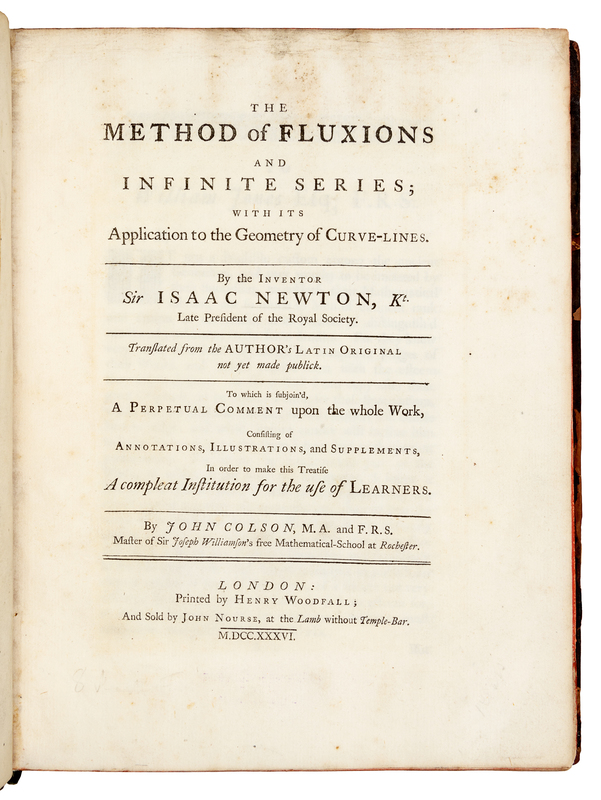Condition Report
Contact Information
Auction Specialist
Lot 64
NEWTON, Isaac, Sir (1642-1727). The Method of Fluxions and Infinite Series; with its Application to the Geometry of Curve-Lines. Translated by John Colson. -- John COLSON (1680-1760). A Perpetual Comment upon the foregoing Treatise. London: Henry Woodfall for John Nourse, 1736. FIRST EDITION, LARGE PAPER COPY.
Sale 714 - Library of a Midwestern Collector
Nov 5, 2019
10:00AM CT
Live / Chicago
Own a similar item?
Estimate
$20,000 -
30,000
Price Realized
$23,750
Sold prices are inclusive of Buyer’s Premium
Lot Description
NEWTON, Isaac, Sir (1642-1727). The Method of Fluxions and Infinite Series; with its Application to the Geometry of Curve-Lines. Translated by John Colson. -- John COLSON (1680-1760). A Perpetual Comment upon the foregoing Treatise. London: Henry Woodfall for John Nourse, 1736.
4to (283 x 218 mm). Engraved plate to face 273 trimmed to rule border and mounted as frontispiece, errata slip and advertisement bound in at end. (A few leaves with mild marginal dampstaining.) Contemporary speckled calf, edges red (neatly rebacked, corners renewed). Provenance: R. Friedländer & Sohn booksellers’ ticket.
FIRST EDITION, LARGE-PAPER COPY. "I thought it highly injurious to the memory and reputation of the great author, as well as invidious to the glory of our own nation, that so curious and useful a piece should be any longer suppress'd" (Colson, Preface). Newton’s Methodus Fluxonum was originally completed in 1671, but was only read by a small circle of intimates and remained unpublished until Colson published his translation nine years after Newton’s death. Before his death, Newton entrusted the publication of his work to Henry Pemberton, who never published it; the original Latin text was not published until 1779.
Whether Newton or German polymath Gottfried Wilhelm Leibniz had priority in discovering differential calculus was a source of great debate. Newton’s fluxational model was employed in a few sections of his Principia in 1687, but Leibniz began publishing papers on the subject in 1684. Leibniz’s manuscript notes, however, date back to 1673, some 8 years after Newton began investigating the subject. By 1671, at the time of its preparation, Newton’s Methodus Fluxonum was the most complete exposition of the fundamental problem of the calculus, in which he presented a successful general method. Babson 171; Norman 1595; Wallis 232.





